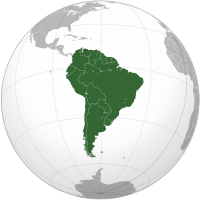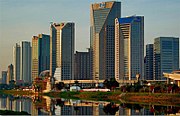 | |
| Area | 17,840,000 km2 (6,890,000 sq mi) |
|---|---|
| Population | 387,489,196 (2011, 5th) |
| Population density | 21.4 per km2 (56.0 per sq mi) |
| Demonym | South American, American[1] |
| Countries | 12 |
| Dependencies | 3 |
| Languages | List of languages |
| Time zones | UTC-2 to UTC-5 |
| Largest cities | |
South America is a continent occupying the southern part of the supercontinent of America. It sits entirely in the Western Hemisphere, and mostly in the Southern Hemisphere with a small portion in the Northern Hemisphere. It is bordered on the west by the Pacific Ocean and on the north and east by the Atlantic Ocean. North America and the Caribbean Sea lie to the northwest.
South America was named in 1507 by cartographers Martin Waldseemüller and Matthias Ringmann after Amerigo Vespucci, who was the first European to suggest that the Americas were not the East Indies, but a New World unknown to Europeans.
South America has an area of 17,840,000 square kilometers (6,890,000 sq mi), or almost 3.5% of the Earth's surface. As of 2005, its population was estimated at more than 371,090,000. South America ranks fourth in area (after Asia, Africa, and North America) and fifth in population (after Asia, Africa, Europe, and North America).
Regions edit
The countries in the table below are categorised according to the scheme for geographic regions and subregions used by the United Nations, and data included are per sources in cross-referenced articles. Where they differ, provisos are clearly indicated.

| Country or territory with flag | Area (km²)[2](per sq mi) | Population (July 2008 est.)[2] | Population density per km² | Capital |
|---|---|---|---|---|
 Argentina Argentina | 2,766,890 km2 (1,068,302 sq mi) | 40,677,348 | 14.3/km² (37/sq mi) | Buenos Aires |
 Bolivia Bolivia | 1,098,580 km2 (424,164 sq mi) | 9,247,816 | 8.1/km² (21/sq mi) | La Paz, Sucre[3] |
 Brazil Brazil | 8,514,877 km2 (3,287,612 sq mi) | 191,908,598 | 22.0/km² (57/sq mi) | Brasília |
 Chile[4] Chile[4] | 756,950 km2 (292,260 sq mi) | 16,454,143 | 21.1/km² (54.6/sq mi) | Santiago |
 Colombia Colombia | 1,138,910 km2 (439,736 sq mi) | 45,013,674 | 37.7/km² (97.6/sq mi) | Bogotá |
 Ecuador Ecuador | 283,560 km2 (109,483 sq mi) | 13,927,650 | 47.1/km² (122/sq mi) | Quito |
 Falkland Islands (UK)[5] Falkland Islands (UK)[5] | 12,173 km2 (4,700 sq mi) | 2,967 | 0.24/km² (0.6/sq mi) | Stanley |
 French Guiana (France) French Guiana (France) | 91,000 km2 (35,135 sq mi) | 209,000 | 2.1/km² (5.4/sq mi) | Cayenne |
 Guyana Guyana | 214,970 km2 (83,000 sq mi) | 770,794 | 3.6/km² (9.3/sq mi) | Georgetown |
 Paraguay Paraguay | 406,750 km2 (157,047 sq mi) | 6,347,884 | 15.6/km² (40.4/sq mi) | Asunción |
 Peru Peru | 1,285,220 km2 (496,226 sq mi) | 27,925,628 | 21.7/km² (56.2/sq mi) | Lima |
 South Georgia and South Georgia andSouth Sandwich Islands (UK)[6] | 3,093 km2 (1,194 sq mi) | 20 | 0/km² (0/sq mi) | Grytviken |
 Suriname Suriname | 163,270 km2 (63,039 sq mi) | 438,144 | 2.7/km² (7/sq mi) | Paramaribo |
 Uruguay Uruguay | 176,220 km2 (68,039 sq mi) | 3,477,778 | 19.4/km² (50.2/sq mi) | Montevideo |
 Venezuela Venezuela | 912,050 km2 (352,144 sq mi) | 26,414,815 | 27.8/km² (72/sq mi) | Caracas |
| Total | 17,824,513 | 382,426,313 | 21.5/km² |
Economy edit



Due to histories of high inflation in nearly all South American countries, interest-rates and thus investment remain high and low, respectively. Interest rates are usually twice that of the United States. For example, interest-rates are about 22% in Venezuela and 23% in Suriname. The exception is Chile, which has been implementing free market economic policies since establishing military dictatorship in 1973 and increased its social spending since the return of democratic rule in the early 1990s. This has led to economic stability and interest rates in the low single digits.
The Union of South American Nations is a planned continent-wide free trade zone to unite two existing free-trade organizations – Mercosur and the Andean Community.
South America relies heavily on the exporting of goods and natural resources. On an exchange rate basis Brazil (the seventh largest economy in the world and the second largest in America) leads the way in total amount of exports at $137.8 billion dollars followed by Chile at 58.12 billion and Argentina with 46.46 billion[7]
The economic gap between the rich and poor in most South American nations is considered to be larger than in most other continents. In Venezuela, Paraguay, Bolivia and many other South American countries, the richest 20% may own over 60% of the nation's wealth, while the poorest 20% may own less than 5%. This wide gap can be seen in many large South American cities where makeshift shacks and slums lie adjacent to skyscrapers and upper-class luxury apartments.
| Country | GDP (nominal) of 2006[8] | GDP (PPP) of 2005[9] | GDP (PPP) per capita of 2005[9] | HDI of 2007 |
|---|---|---|---|---|
 Argentina Argentina | 214,058 | 419,600 | 11,076 |  0.869 0.869 |
 Bolivia Bolivia | 11,163 | 34,200 | 3,623 |  0.695 0.695 |
 Brazil Brazil | 1,312,962 | 1,585,100 | 8,606 |  0.800 0.800 |
 Chile Chile | 145,841 | 199,800 | 12,277 |  0.867 0.867 |
 Colombia Colombia | 135,836 | 264,000 | 6,314 |  0.791 0.791 |
 Ecuador Ecuador | 40,800 | 86,400 | 6,541 |  0.772 0.772 |
 French Guiana (France) French Guiana (France) | 3,524[10] | N/A | 17,336 (nominal, 2006)[10] | N/A |
 Guyana Guyana | 896 | 2,393 | 3,186 |  0.750 0.750 |
 Paraguay Paraguay | 9,110 | 23,000 | 3,905 |  0.755 0.755 |
 Peru Peru | 107,000 | 217,500 | 7,574 |  0.773 0.773 |
 Suriname Suriname | 1,597 | 2,591 | 5,770 |  0.774 0.774 |
 Uruguay Uruguay | 19,308 | 30,700 | 9,277 |  0.852 0.852 |
 Venezuela Venezuela | 181,862 | 262,800 | 9,888 |  0.792 0.792 |
Culture and language edit


Portuguese and Spanish are the most spoken languages in South America, each spoken by around 90% of the continent's population. Portuguese is the official language of Brazil, which holds nearly 50% of the South American population. Spanish is the official language of most countries of the continent. Dutch is the official language of Suriname; English is the official language of Guyana, although there are at least twelve other languages spoken in the country such as Hindi, Arabic, and various indigenous dialects. English is also spoken in the Falkland Islands. French is the official language of French Guiana.
Indigenous languages of South America include Quechua in Ecuador, Peru, and Bolivia; Guaraní in Paraguay and, to a much less extent, in Bolivia; Aymara in Bolivia, Peru, and less often in Chile; and Mapudungun is spoken in certain pockets of southern Chile and, more rarely, Argentina. At least three South American indigenous languages (Quechua in Ecuador, Peru, and Bolivia - Aymara also in Bolivia - and Guarani in Paraguay) are recognized along with Spanish as national languages.
Other languages found in South America include Hindi and Indonesian in Suriname; Italian in Argentina, Brazil, Uruguay, Venezuela, and Chile; and German in certain pockets of Argentina, Chile, Venezuela and Paraguay. German is also spoken in many regions of the southern states of Brazil, Riograndenser Hunsrückisch being the most widely spoken German dialect in the country; among other Germanic dialects, a Brazilian form of Pomeranian is also well represented and is experiencing a revival. Welsh remains spoken and written in the historic towns of Trelew and Rawson in the Argentinean Patagonia. There are also small clusters of Japanese-speakers in Brazil, Bolivia, Colombia, Paraguay, Peru, and Ecuador. Arabic speakers, often of Lebanese, Syrian, or Palestinian descent, can be found in Arab communities in Brazil, Ecuador, Peru, Chile, Argentina, and less frequently in Colombia and Paraguay.
In most of the continent's countries, the upper classes and well-educated people regularly study English, French, German, or Italian. In those areas where tourism is a significant industry, English and some other European languages are often spoken. There are small Spanish speaking areas in Southernmost Brazil due to the proximity of Uruguay.
South Americans are culturally enriched by the historic connection with Europe, especially Spain and Portugal, and the impact of mass culture from the United States of America.
South American nations have a rich variety of music. Some of the most famous genres include cumbia from Colombia, samba and bossa nova from Brazil, and tango from Argentina and Uruguay. Also well known is the non-commercial folk genre Nueva Canción movement which was founded in Argentina and Chile and quickly spread to the rest of the Latin America. People on the Peruvian coast created the fine guitar and cajon duos or trios in the most mestizo (mixed) of South American rhythms such as the Marinera (from Lima), the Tondero (from Piura), the 19th century popular Creole Valse or Peruvian Valse, the soulful Arequipan Yaravi, and the early 20th century Paraguayan Guarania. In the late 20th century, Spanish rock emerged by young hipsters influenced by British pop and American rock in Argentina, Chile, Colombia, Peru, and Uruguay. Brazil has a Portuguese-language pop rock industry as well a great variety of other music genres.

The literature of South America has attracted considerable critical and popular acclaim, especially with the Latin American Boom of the 1960s and 1970s, and the rise of authors such as Gabriel García Márquez in novels, and Pablo Neruda and Jorge Luis Borges in other genres.
Because of South America's broad ethnic mix, South American cuisine takes on African, American Indian, Asian, and European influences. Bahia, Brazil, is especially well-known for its West African-influenced cuisine. Argentines, Chileans, and Uruguayans regularly consume wine while Argentina along with Paraguay, Uruguay, and people in southern Chile and Brazil enjoy a sip of mate a regional brewed herb cultivated for its drink, the paraguayan version, terere, differing from the others in that it's served cold. Pisco is a liquor distilled from grapevine produced in Peru and Chile; however, there is a recurring dispute between those countries regarding its origins. Peruvian cuisine mixes elements from Chinese, Japanese, Spanish, African, Andean, and Amazonic food.
Demographics edit
Descendents of Indigenous peoples, such as the Quechua and Aymara, make up the majority of the population in Bolivia and are a significant element in most other former Spanish colonies. Exceptions to this include Argentina, Brazil, and Uruguay where people of European descent make up the majority of the population. Mestizos (mixed white and Amerindian) are the largest ethnic group in Peru, Paraguay, Venezuela, Chile, Colombia, and Ecuador. African descendants are also a significant group in Brazil, Colombia, Venezuela and Ecuador. Suriname is the only country in South America where Asians form the majority of the population. Peru has the main Chinese community in Latin America and the second Japanese community (after Brazil).
Indigenous peoples edit
|
References edit
Content notes edit
^ Continent Model: In some parts of the world South America is viewed as a subcontinent of America[11][12] (a single continent in these areas), for example Latin America, Latin Europe, and Iran. In most of the countries with English as an official language, however, it is considered a continent.See Continent.
Notes edit
- ^ American, Merriam-Webster OnLine.
- ^ a b Land areas and population estimates are taken from The 2008 World Factbook which currently uses July 2007 data, unless otherwise noted.
- ^ La Paz is the administrative capital of Bolivia; Sucre is the judicial seat.
- ^ Includes Easter Island in the Pacific Ocean, a Chilean territory frequently reckoned in Oceania. Santiago is the administrative capital of Chile; Valparaíso is the site of legislative meetings.
- ^ Claimed by Argentina.
- ^ Also claimed by Argentina, the South Georgia and the South Sandwich Islands in the South Atlantic Ocean are commonly associated with Antarctica (due to proximity) and have no permanent population, only hosting a periodic contingent of about 100 researchers and visitors.
- ^ https://www.cia.gov/library/publications/the-world-factbook/rankorder/2078rank.html
- ^ Source: [1]
- ^ a b Source: [2]
- ^ a b (in French) INSEE-CEROM. "Les comptes économiques de la Guyane en 2006 : premiers résultats" (PDF). Retrieved 2008-01-14.
- ^ "South America Travel, Tour To South America Continent". Retrieved 2007-05-19.
- ^ Ambassador Rubens how do I make a violin A. Barbosa. "MERCOSUL IN THE REGIONAL CONTEXT". Retrieved 2007-05-19.
Sources edit
- "South America". The Columbia Gazetteer of the World Online. 2005. New York: Columbia University Press.
- GeoHive: The population of continents, regions and countries
See also edit


External links edit
- News
- (in Spanish) Infolatam. Information and analysis of Latin America
- (in English) The Council on Hemispheric Affairs An independent source of Latin American news and opinion
- Sports
- (in Spanish and English) CONMEBOL -- Confederación Sudamericana de Fútbol (The South American Football Confederation)
South America also has Rugby, Auto Racing, Golf, and Kayaking.
- Music
- (in French) Information about South American Music. Also MP3 & video.
- Diana Mercado from Barranquilla, Colombia Objetivo Fama 5
- Tourism
















